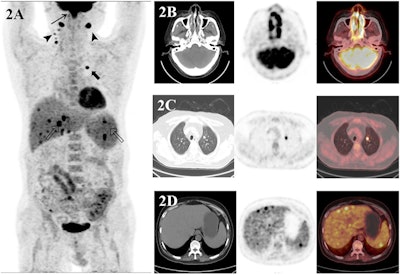
[ad_1]
PET/CT has significant advantages over traditional methods in detecting and staging lesions in patients with natural killer/T-cell lymphoma, a study published on December 18th found. Helion.
In a retrospective analysis, a team in Taiyuan, China found that F-18 FDG-PET/CT was superior in analyzing imaging findings in NK/T cell lymphoma, suggesting that this scan could improve treatment plans for patients. suggested.
“F-18 FDG-PET/CT scans are critical in identifying tumor lesions, determining staging, and devising treatment strategies for individuals diagnosed with NK/T-cell lymphoma,” said lead author No. Yamanishi. wrote Huixia Geng, MD, of the Tri-Hospital. medical university.
NK/T cell lymphomas originate from mature T cells and NK cells. The authors explained that although the disease has a low incidence, it progresses rapidly and patient survival is poor.
Previous studies have shown that F-18 FDG-PET/CT is important for determining staging, response assessment, and prognostic assessment of diffuse large B-cell lymphoma, Hodgkin lymphoma, and follicular lymphoma. However, it has not yet been established in NK patients. /T-cell lymphoma, they added.
To achieve this objective, the research group analyzed the PET/CT image features of 38 patients with a primary diagnosis of NK/T-cell lymphoma and compared their approach to traditional methods, namely physical examination, venography, and Comparisons were made with CT, MRI, and biopsy from the primary site. , bone marrow examination, etc.
According to the analysis, patients had a total of 219 lesions (including 81 nodular lesions and 138 extranodal lesions) with positive malignancy tests. PET/CT significantly outperformed conventional methods in detecting malignant lesions, detecting 79 extranodal lesions (98.8%) compared to 45 (56.3%).
 A 50-year-old man recently diagnosed with nasal-type NK/T-cell lymphoma underwent an F-18 FDG-PET/CT scan (A-D) for initial staging. Maximum intensity projection image (A) shows hypermetabolic lesions in both ethmoid sinuses (thin arrows), both cervical lymph chains (arrowheads), left upper lung (thick arrow), liver, and spleen. Transaxial image shows his F-18 FDG connective masses in both ethmoid sinuses (B). Scan shows strong his F-18 FDG radiotracer uptake in the left upper lung and uptake in the liver and spleen (CT showed no lesions), suggestive of malignancy (CD) . Finally, the patient’s staging was changed from II to IV after a PET/CT scan was performed.Image provided by Helion
A 50-year-old man recently diagnosed with nasal-type NK/T-cell lymphoma underwent an F-18 FDG-PET/CT scan (A-D) for initial staging. Maximum intensity projection image (A) shows hypermetabolic lesions in both ethmoid sinuses (thin arrows), both cervical lymph chains (arrowheads), left upper lung (thick arrow), liver, and spleen. Transaxial image shows his F-18 FDG connective masses in both ethmoid sinuses (B). Scan shows strong his F-18 FDG radiotracer uptake in the left upper lung and uptake in the liver and spleen (CT showed no lesions), suggestive of malignancy (CD) . Finally, the patient’s staging was changed from II to IV after a PET/CT scan was performed.Image provided by Helion
Furthermore, the clinical staging of 15.7% (6 of 38) of patients was reclassified to varying degrees after PET/CT findings, and the PET/CT results were This helped me change my treatment plan. the group wrote.
Specifically, there were 2 cases in which radiation therapy alone was changed to radiation therapy combined with chemotherapy, and 2 cases in which chemotherapy combined with radiation therapy was changed to chemotherapy alone due to stage-up. PET/CT scans changed the target area for radiation therapy in three patients, the researchers added.
“Our results suggest that PET/CT has significant advantages over it. [conventional methods] “Useful for lesion detection and staging of extranodal NK/T-cell lymphoma,” the group wrote.
Ultimately, the authors point out that the advantage of PET/CT is that it can combine both structural imaging and functional metabolic information. According to the authors, this non-invasive hybrid approach allows clinicians to analyze the morphology, location, and invasion of lesions in a single examination, compared to traditional sequential methods.
“Our findings in NK/T-cell lymphoma highlight the importance of PET/CT in lesion detection and early staging,” the research group concluded.
You can read the full article here.
[ad_2]
Source link







